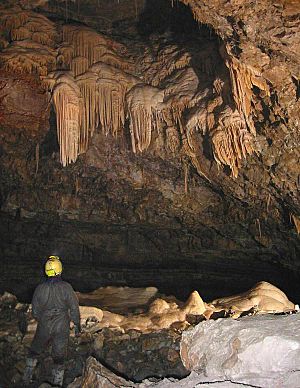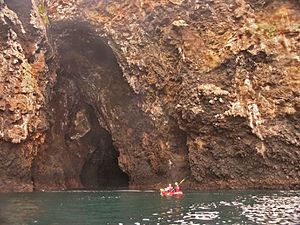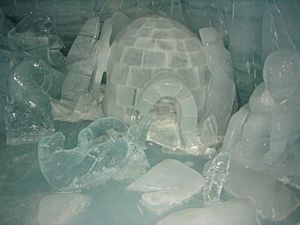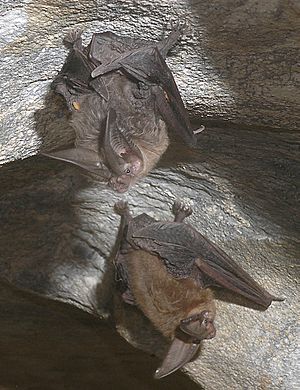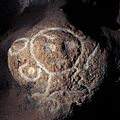Cave facts for kids
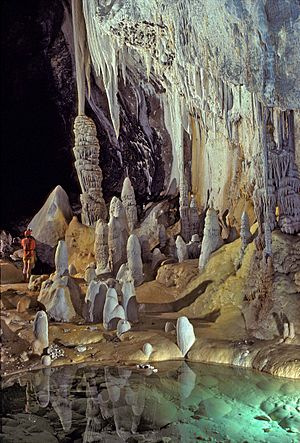
A cave is a natural space underground. It must be big enough for a person to enter. Some people think a true cave needs parts that are always dark. But usually, the word "cave" includes smaller spots. These can be sea caves, rock shelters, or grottos.
The scientific study of caves is called speleology. When people explore caves for fun or science, it's called "caving" or "potholing". In the US and Canada, it's sometimes called "spelunking".
Contents
How Do Caves Form?
Caves are made by natural processes over a long time. This can involve chemicals, water wearing away rock, or even tiny living things. Most caves form in limestone rock. Water slowly dissolves the rock.
Solutional Caves: Water at Work
Solutional caves form where rock can dissolve. They are most common in limestone. But they can also form in chalk, dolomite, or even salt.
Limestone dissolves when rainwater or groundwater mixes with acids. This process creates a special landscape called karst. Karst areas have sinkholes and underground rivers. Limestone caves often have amazing formations. These are called speleothems. They form as minerals slowly drip and harden. Examples include flowstone, stalactites (hanging from the ceiling), and stalagmites (growing from the floor).
Lechuguilla Cave in the New Mexico, USA, is famous for its beauty. It formed differently. Gas from deep underground mixed with water. This created a strong acid that dissolved the limestone from below.
Primary Caves: Born with the Rock
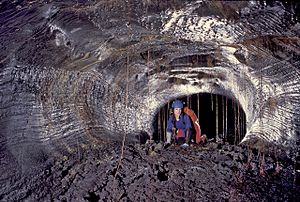
Some caves form at the same time as the rock around them. These are called primary caves.
The most common primary caves are lava tubes. They form during volcanic eruptions. Hot lava flows downhill. The surface cools and hardens. But the hot lava inside keeps flowing. If most of the liquid lava drains out, a hollow tube is left behind. You can find these caves in places like Tenerife and Big Island. Kazumura Cave in Hawaii is a very long lava tube, about 65.6 kilometers (40.8 miles) long.
Sea Caves: Shaped by Waves
Sea caves are found along coastlines. They are created by ocean waves hitting weak spots in sea cliffs. These weak spots might be cracks in the rock. Sea caves are usually 5 to 50 meters (16 to 164 feet) long. Some can be over 300 meters (984 feet) long.
Glacier Caves: Ice and Meltwater
Glacier caves form inside or under glaciers. They are made by melting ice. The slow movement of the ice can also make these caves change shape or close up. Sometimes, these are called ice caves. But that term is also used for caves that have ice formations all year.
Other Types of Caves
- Fracture caves form when soft minerals between rock layers dissolve. The harder rocks then crack and fall apart.
- Talus caves are spaces between large rocks that have fallen into a pile. You often see them at the bottom of cliffs.
- Anchihaline caves are usually near coasts. They have a mix of fresh and salty water. Many unique animals live in these caves.
Cave Patterns
Caves can have different shapes or patterns. These patterns tell us how the caves formed.
- Branchwork caves look like tree branches or river systems. Many small passages join together into larger ones.
- Angular Network Caves have straight, narrow passages that cross each other. They form when cracks in the rock are widened by water.
- Anastomotic Caves look like braided rivers. Passages split apart and then join back together.
- Spongework caves have many small, connected holes. They look like a sponge. They form when different types of water mix and dissolve the rock.
- Ramiform caves have large, irregular rooms and passages. They form when rising water dissolves the rock.
Where Are Caves Found?
Caves are found all over the world. But many have not been explored yet. Most known caves are in countries where caving has been popular for a long time. These include France, Italy, Australia, the UK, and the United States.
So, many explored caves are in Europe, Asia, North America, and Oceania. Fewer are known in South America, Africa, and Antarctica. This might change as more people explore caves in new areas. For example, China has a lot of limestone. But it has relatively few documented caves so far.
Cave Records and Superlatives
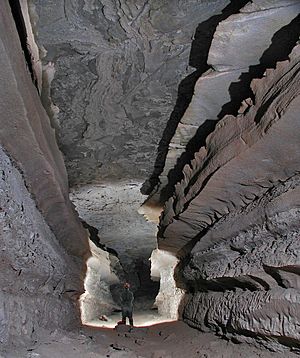
- The longest cave system ever explored is Mammoth Cave in Kentucky, US. It is 675.9 kilometers (419.9 miles) long.
- The longest underwater cave is Sistema Ox Bel Ha in Yucatán, Mexico. It is 436 kilometers (271 miles) long.
- The deepest known cave is Veryovkina Cave in Abkhazia, Georgia. It is 2,204 meters (7,231 feet) deep. This was the first cave explored deeper than 2,000 meters.
- The deepest vertical drop inside a cave is 603 meters (1,978 feet). It is in Vrtoglavica Cave in Slovenia.
- The largest known cave room by volume is the Miao Room. It holds 10,780,000 cubic meters (380,690,000 cubic feet) of space.
- The largest known cave room by surface area is Sarawak Chamber in Malaysia. It covers 154,500 square meters (1,663,000 square feet).
- The largest passage ever found is in Son Doong Cave in Vietnam. It is 4.6 kilometers (2.9 miles) long. It is often 80 meters (260 feet) high and wide. Some parts are over 140 meters (460 feet) high and wide.
Top 5 Longest Explored Caves
- Mammoth Cave, Kentucky, US
- Sistema Ox Bel Ha, Mexico
- Sistema Sac Actun/Sistema Dos Ojos, Mexico
- Jewel Cave, South Dakota, US
- Shuanghedong Cave Network, China
Cave Animals
Animals that live in caves are grouped by how much they depend on the cave.
- Troglobites live only in caves.
- Troglophiles can live in caves or other places.
- Trogloxenes use caves for shelter but need to leave to find food.
- Accidentals are animals that just wander into a cave by chance.
Troglobites are very special. They often have unique features. They might lose their color, becoming pale or white. They might lose their eyes or their eyesight. Their legs or antennae might become very long. They also develop better senses, like feeling vibrations.
Aquatic troglobites, like the endangered Alabama cave shrimp, live in cave waters. They eat tiny bits of food that wash into the cave. They also eat bat droppings. Other aquatic cave animals include cave fish and the Olm.
Bats, like the Gray bat, are trogloxenes. They live in caves but fly out to hunt for food. Some cave crickets are also trogloxenes. They rest in caves during the day and look for food outside at night.
Cave ecosystems are very delicate. Many endangered species live in caves. These include the Tooth Cave spider and the Gray bat.
Caves in History and Society
Throughout history, people have used caves. They used them for shelter, burials, or religious sites. Things left in caves are often well-preserved. This makes caves important places for archaeologists to learn about the past. Cave paintings are especially interesting. For example, the Great Cave of Niah in Malaysia shows human life from 40,000 years ago.
Caves are also important for studying geology. They can show us what past climates were like.
Today, caves are used for fun. Caving is a popular sport. For those who want an easier visit, many beautiful caves are "show caves". They have lights and paths for visitors. Caves are also used for BASE jumping and cave diving.
Caves are also good for storing things. The cool, steady temperature and high humidity in most caves are perfect for aging wine and cheese.
Caves and Sound
Sound has always been important in caves. Ancient people painted dots and lines in parts of caves that had special echoes. These spots might have been used for music or rituals. Paintings were often found where the sound was best. Sometimes, the sounds even matched the animals painted on the walls. People might have used their voices to find their way in dark areas.
Caves are still used for sound today. Cumberland Caverns is a great example. The uneven cave walls scatter sounds. This makes the space sound like a recording studio. In the 20th century, musicians like Dinah Shore and Benny Goodman performed in caves. These early shows were often near the cave entrance. This was because it was hard to bring equipment deeper inside. In Luray Caverns, Virginia, there is an organ that plays music by hitting stalactites. Each stalactite makes a different sound.
Images for kids
-
Domica Cave in Slovak Karst (Slovakia)
-
Olms in a Slovenian cave
-
Taíno petroglyphs in a cave in Puerto Rico
See also
 In Spanish: Cueva para niños
In Spanish: Cueva para niños


